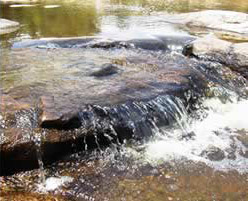Alabama Irrigation Initiative Receives NOAA Grant

Water, water everywhere...but how do we put it to use?
That's the question that may soon be answered through a multi-year $877,000 grant recently awarded by the National Oceanic and Atmospheric Administration (NOAA) to five Alabama colleges or universities, including Auburn.
According to Donn Rodekohr, statewide program coordinator for the project in the CoAg Department of Agronomy and Soils and the research coordinator for the grant, the money was awarded to the University of Alabama at Huntsville, Auburn, the University of Alabama at Tuscaloosa and to Tuskegee and Alabama A&M universities. Other partners involved in the grant are the Alabama Department of Agriculture and Industries, Alabama Department of Environmental Management, Office of Water Resources, U.S. Geological Survey, U.S. Environmental Protection Agency and the U.S. Army Corps of Engineers.
Initially the research team, which is being led by Jim Hairston, CoAg professor of agronomy and soils, and UAH atmospheric scientist Richard McNider, will look at mitigating local and regional agricultural droughts by increasing irrigation using cool-season runoff in Alabama.
The Auburn research team will be addressing issues through a multidisciplinary approach involving researchers and scientists from the CoAg Department of Agronomy and Soils, Biosystems Engineering and Agricultural Economics and Rural Sociology. The scientists will be looking at water as a resource and looking at water management as a tool for economic good and for food and homeland security.
The key, says Rodekohr, is that the Southeast, unlike the arid West, has the ability to produce agricultural products sustainably, putting less stress on water resources because the region has significant rainfall.
"The driving factor behind the grant is that Western irrigated agriculture was developed to ‘make the desert bloom,' but now water is becoming a scarce commodity, physically and administratively, and the irrigated West is no longer sustainable," he says.
As water resources tighten in the West, agricultural land will be taken out of production, but the need for agricultural products will not decrease. Rodekohr notes that crop production could shift to the Southeast, where water is an abundant and untapped resource.
"In southeastern states in particular, we have looked at water not as a manageable commodity, but often as a problem," he says. "The result is that the administrative system is not well configured to develop and protect water. We need to develop adequate plans and policies so we don't just react to a water crisis, but proactively address alternatives."
"This has a high potential of improving the overall economic stability and outlook of the state," says Rodekohr. "Environmental impacts and constraints will play major roles. Designs must be cognizant of our state's rich biodiversity." Ultimately, the team hopes to make water management a state priority.
Auburn University will get $170,000 per year for the first two years of funding with another $900,000 per year in the future.
